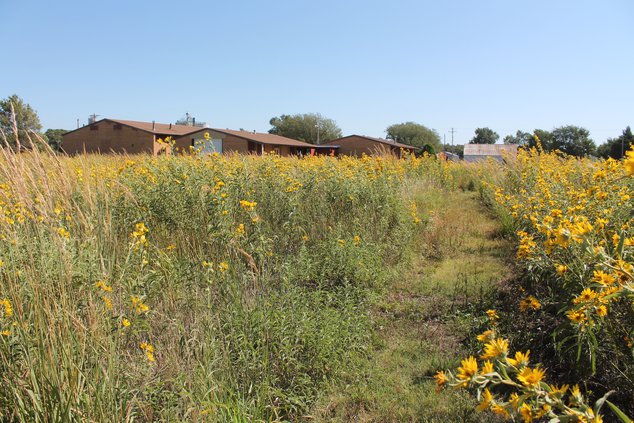RURAL ALBERT — Thousands of Monarch butterflies are making a return to visit Troy Schroeder’s property this year. Their appearance coincides with the mass migration of the colorful harbingers of fall as they make their way into Kansas on route to Mexico where they will overwinter. It’s a sure sign that purposely planting pollinator-attracting grasses and flowers may be helping to support this species which has seen massive declines in recent decades.
Around mid-September, he begins sighting them at his rural Albert farm where they flutter and feed by day on nectar from the Maximillian sunflowers that border the long driveway leading up to his home.
By night, they rest in the branches of mature Burr Oaks until morning.
Schroeder is mindful their stay will be brief, and makes time in the morning to stop under the oaks to observe the Monarchs as they reanimate and begin stretching their wings in preparation for their travels later in the day.
The property has been in the Schroeder family for more than three generations. Early on, Monarchs were plentiful and likely taken for granted. It became his in the 1990s. He went to work planting the windbreak around the property and adopted several conservation practices to protect from water and soil erosion and provide for the wildlife that inhabits the area. In recent years, practices to protect and support pollinator insects and Monarch butterflies introduced by state and federal governmental agencies and nonprofits have provided valuable cost-share opportunities for some landowners. These efforts are beginning to pay off.
In recent years, Schroeder enrolled about 50 acres into the Conservation Stewardship Program pollinator project offered through the Natural Resources Conservation Service. Travelers along K-96 west of Albert can’t miss it as they near the turnoff to Otis. On the south side of the highway, a 50-acre burst of yellow Maximillian sunflowers topped by a handful of cedars grabs the eye, with a border of the cheery yellow flowers tracing the border of the property.
Carefully entering the access-controlled field, Schroeder points out various native grasses and blue pitcher sage and other flowers helping to fill out the planting. The prescribed mix and conservation plan was provided through the Natural Resources Conservation Service. He chose the location with travelers in mind. He imagined eastbound drivers coming over the hill and seeing the rise covered in wildflowers.
“I imagine the sight of all these Maximillian sunflowers also draws in the Monarchs as they are migrating,” he said.
A mix of hardy annuals and perennials, the landscape is ever-evolving and changing from one year to the next.
The program targets highly erodible land and spaces where farming is more difficult and thus less profitable. By replacing non-native plantings with native grasses and forbs, soil is better anchored, plants thrive with naturally present moisture and rainfall, and wildlife can find cover and food needed to survive.
Results like Schroeder’s don’t happen overnight. The first year, he admits he thought he’d made a mistake. Few of the pollinator species were visible and a number of annual weeds had popped up.
“It looked awful,” he said. “From a distance it just looked like a patch of weeds.”
Upon closer examination though, he was able to identify some of the pollinator species beginning to take hold.
He put down pre-emergent herbicide in the early spring, which kept the annual weeds from germinating and growing the next season. The second year, the pollinator species thrived. The third year, the planting was firmly established and filling in. Each year, some species will thrive and others will have only supporting rolls, and this is normal, Schroeder said.
While it takes a few years for a pollinator garden to become established and provide the sought-after benefits, it’s well worth the effort.
“I hope these pollinator plants remain for years to come,” Schroeder said, as he gazed out over the 50-acre planting. “This is my feel-good space.”
STORIES AND PHOTOS BY VERONICA COONS
Barton County Conservation District
Special to the Tribune
Pollinators protected at Albert school building


The 50 acres near Troy Schroeder’s home are only one of the plantings he manages.
A few years ago he established a pollinator garden on two acres on the west side of the old Albert school in southwest Barton County. He utilized the Kansas Department of Wildlife, Parks and Tourism program Habitat First to receive assistance with planning and sharing the cost of planting the project.
Schroeder hopes people interested in protecting pollinators will stop and visit. The school, which closed several years ago, is located on NW 130 Ave. on the western edge of the city of Albert. Visitors can park in the grassed lot in front. A mown path provides access to the diversity of native plants and pollinator insects present. A small sign posted at the entrance reminds those maintaining the surrounding property the planting is wildflowers and should be protected.
For more information about the Habitat First program, go to https://ksoutdoors.com/Services/Private-Landowner-Assistance/Wildlife-Biologists/Habitat-First-Program.





